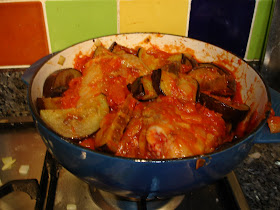Sadly, my travel CV does not include Morocco. This is an omission which, if time and money will allow, I hope to rectify. That doesn't have to stop me enjoying the flavours of this fascinating country whose food is influenced by a wide range of cultures; Arabic, Berber, Moorish and of course, its neighbours around the Mediterranean. Moroccan food is more spicy than that of either the Mediterrean nations or the middle-east. Perhaps this is why it appeals to many in the UK, who have welcomed spicy food onto their tables and into their hearts.
Lamb is the favourite meat of the Moroccans, and given their talent for either marinading it or slow cooking it, I can see why. However, beef is the most frequently eaten meat owing to its lower cost. Most of us are familiar with the 'tagine'; a stew consisting of meat often cooked with fruits such as dried apricot, raisin or preserved lemons. What some may not know is that 'tagine', much like the word 'paella' in Spain, refers to the cooking dish rather than the food itself. A tagine is the two part cooking utensil consisting of a large circular base with a high lip where the food is placed and a conical lid with a hole in the top which acts like a chimney. The tagine is put on a stand over a small wood fire. Here in Europe, you can buy cast iron tagine pots (Le Creuset make a particularly attractive but somewhat costly one) which can go straight on the hob. If you go to Morocco and buy a traditional tagine, you cannot put it directly on the hob or the terracotta will crack and send your stew all over the place! You will need heat diffuser to go underneath it.
I don't own a tagine, my kitchen is only a medium sized one and is full of a huge amount of kitchen paraphernalia as it is. Given that Him Indoors and I cook regularly, the kitchen is heaving with utensils, gadgets and foodstuffs. I just can't keep it tidy, although it is always clean. So this stew has been cooked in a casserole dish. I don't think it suffers as a result, but would be interested to know if anyone has tried using a tagine as well as a casserole and whether there is any difference in flavour.
(serves 2)
Ingredients:
4 small onions, chopped
4-5 cloves garlic, finely chopped
2 bay leaves
2 small sticks of cinnamon
½ tsp cumin seeds
½ tsp paprika
1 x 400g tin chickpeas, drained and rinsed
1 x 400g tin tomatoes, chopped
2 lamb shanks
1 aubergine, cut into half moon slices
1 tbsp tomato puree
1 teaspoon harissa
a little flour – for coating the lamb shanks
a little water – to loosen the stew if getting too thick
Salt
Ground black pepper
Some olive oil
Method:
- Preheat your oven. You will need a temperature of 195°C for conventional oven or 175°C for a fan oven. This dish is best cooked in a flameproof casserole type dish like a cast iron casserole dish.
- Firstly, heat some olive oil (about 2 tbsp) in the dish. As this is happening, lightly coat the lamb shanks in flour and when the oil is hot, add them in. When they are browned all over, remove them to a plate.
- Add more olive oil and start frying the aubergine until browned. This is best done when the pan is good and hot, so that the aubergine doesn't soak up lots of oil when cooking. Cook in small batches so the pan doesn't cool down or get too congested. Place with the browned lamb when done.
- Add a little more olive oil (this is not diet food, I'm afraid!) and fry the onions for about 6 minutes. Add the garlic and cinnamon and cook for another 4 minutes. Then add the puree and harissa, stir thoroughly to mix and cook for 3 minutes to cook the flavours out.
- Add the tinned tomatoes, chick peas, salt and pepper (to taste) and some water if needed. You want the lamb completely covered by the stew so that it stews and doesn't roast instead. Turn the heat up and bring to the boil.
- Once you have done all of this, your work is almost done. Pop the casserole dish in the oven and put your feet up. The stew will be done in 1½-2 hours depending on your oven, size of dish, amount of fluid, etc. The stew will be ready when the lamb is so tender is practically falling off the bone. If that means putting it back in the oven for an extra 20-40 minutes, go ahead.
- Serve with crusty bread, although couscous or rice will probably go well with the juicy sauce.











Love it
ReplyDeleteDear Anonymous,
ReplyDeleteThank you so much! Wow!
Love
Snigdha